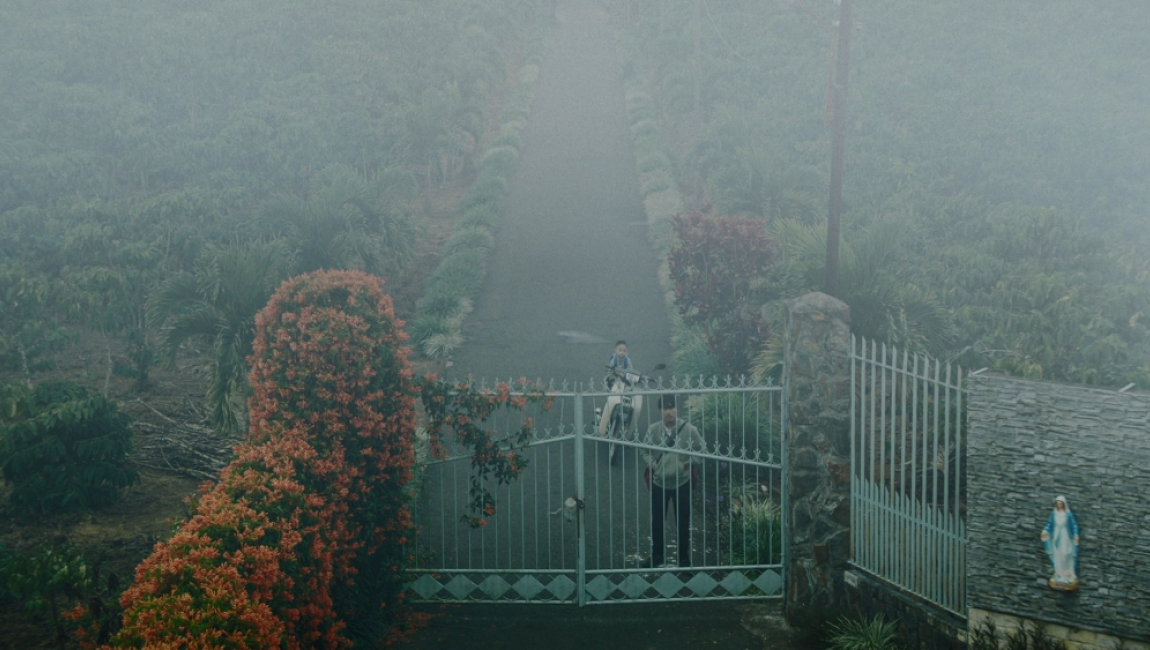Newly christened Director’s Fortnight General Delegate Julien Rejl has expressed a desire to highlight new voices with his first programmed slate — not just by selecting filmmakers who are early in their careers, but also films still lacking sales representation. And it’s a gesture toward the success of this strategy that the 2023 Camera d’Or — awarded to the best first film premiering at Cannes overall — went to a work from this section: Phạm Thiên Ân’s Inside the Yellow Cocoon Shell.
Pham’s film begins with a long shot in which the focal point shifts four separate times. Starting on a soccer game, the camera eventually tracks a mascot (who had been motionless in the foreground) into an open air cafe, then settling on a group of three men discussing faith — one of whom is Thien (Lê Phong Vũ), the film’s main character. Though this conversation lasts quite a while, Pham has one more camera move in store for us: soon outside the cafe it begins to rain, and then suddenly, a crash is heard off-camera, before we pan over to the aftermath of a motorcycle accident. As it turns out, Inside the Yellow Cocoon Shell is a film composed almost entirely of long takes like this one; it’s already earned comparisons to those from the likes of Bi Gan and Apichatpong Weerasethakul. But from the beginning, Pham’s film seems uniquely self-aware, intentionally foregrounding the qualities of the long-take school of filmmaking that tend to receive both the most praise and the harshest criticism.
Though the plot of Inside the Yellow Cocoon Shell revolves around Thien taking care of his nephew after a deadly motorcycle crash, it’s not the same crash as the one featured in the film’s first shot, as Thien won’t receive the call that his sister-in-law has died until it interrupts a massage later in the evening. After Thien picks up his nephew Dao at the hospital, the film cuts to what seems to be a non sequitur, with a man explaining the traditional meanings of various dishes at a wedding. Eventually, a still photographer enters the shot, and we hear a voice offscreen ask him to move as the camera shakes. The footage then pauses and rewinds — we realize we are seeing a screen capture of Thien’s work as a video editor. When Thien returns to Dao, he is still unable to explain to his nephew what has happened to his mother, and it’s here that Pham employs another fashionable flourish: the late title card drop. Though inserting a title card 30 minutes into a film always offers a bit of a Brechtian shock, here it follows an even more arresting breach of the fourth wall. Because there are few to no cuts in each lengthy scene, almost every cut means a shift not only in space, but in time, increasing the gravity of each edit. In the case of the title card, the cut represents a significant elision, as it is immediately followed by a shot of Thien’s sister-in-law’s coffin — but viewers never see the moment in which Dao learns his mother has died.
This formal inventiveness is consistent across the film’s runtime. Its longest take opens at a relative’s home in the village where Thien grew up. While Dao plays, the relative approaches Thien to discuss the cost of his sister-in-law’s funeral, agreeing to split it but also asks Thien to bring some money to Mr. Luu, who prepared the burial shroud and had refused payment. Thien hops on a motorbike, and the sudden mobility of the camera as it follows him will be immediately familiar to fans of the aforementioned Bi Gan’s Kaili Blues. But when Thien arrives at Mr. Luu’s house, the camera is positioned across the road. There appears to be a slow zoom on the window as Thien enters and home and sits with Mr. Luu, but when the former rises, in perhaps the film’s greatest formal surprise, the camera follows him, having somehow made it inside. Later, Thien is shown climbing a tower, reaching a broken down set of stairs and hoisting himself up onto the wall to continue. It lands as something of a joke, then, that Pham cuts to the top of a tower rather than following the ascent.
These long shot escapades are intelligently utilized and sufficiently exciting to sustain even Cocoon Shell’s three-hour runtime, and though the film’s narrative isn’t quite as deft, there are still pleasures to be found beyond formal invention. The opening conversation about faith between Thien and his friends establishes the film’s core thematic concerns, and the film’s greatest emotional thread is found in Thien’s exploration of faith with his nephew. And in Cocoon Shell’s final hour, it becomes increasingly dreamy in nature, texturally and narratively, as Thien searches for his brother, and Dao’s absent father, Tam. The film’s final minutes ultimately combine the mystical with Pham’s manipulation of time, and though its conclusion doesn’t really offer any concrete answers regarding either faith broadly or Tam’s whereabouts more specifically, it does leave Thien in a most satisfying place.
DIRECTOR: Phạm Thiên Ân; CAST: Le Phong Vu, Nguyen Thi Truc Quynh, Nguyen Thinh; DISTRIBUTOR: Kino Lorber; IN THEATERS: January 19; RUNTIME: 2 hr. 58 min.
Originally published as part of InRO Weekly — Volume 1, Issue 21.5.







